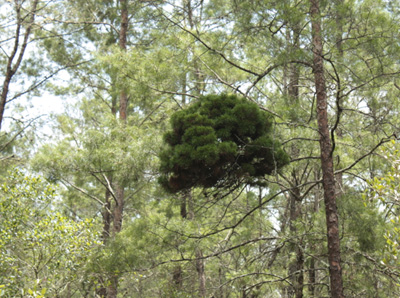Witch's Broom
Natural History

A witch's broom on a sand pine in Ocala National Forest | Photo credit: Niels Proctor
A witch's broom is an unusually dense and compact cluster of twigs and foliage formed on a woody plant. The mass of shoots comes from a common point, giving the growth a broom-like appearance. The witch's broom may last several years. Although witches' brooms might be considered unsightly, they seldom result in serious injury to the tree.
Witches' brooms can be caused by various sources including mites, viruses, fungi, mistletoes, insects, and nematodes. Knowing the type of host plant can help determine the cause of the witch's broom. Witches' brooms can also be caused by a genetic mutation in a plant. These "mutant brooms" are particularly important commercially because their new genetic makeup can lead to new plant cultivars.
One of the most famous broom hunters was Dr. Sidney Waxman, a horticulturist at the University of Connecticut. His 2005 obituary in the New York Times described his work this way:
"As America oozed into tract housing after World War II, there was a demand for trees and shrubs that would fit in the small yards and not grow very much. Over 40 years, Dr. Waxman came up with 40 cultivars, as cultivated plant varieties are known, including the widely planted dwarf pines called Sea Urchin, Blue Shag and Sand Castle.
Todd Forrest, associate vice president for horticulture and living collections at the New York Botanical Garden, said Dr. Waxman's importance had transcended the popular plants he developed. Mr. Forrest said Dr. Waxman had 'systematically established' the method of getting seeds from witches' brooms, which often appear as large, tangled clumps of branches, sometimes with miniature leaves, on full-size trees.
Some of the clumps are caused by disease, but some are sports, or natural mutations, with desirable new genetic characteristics that are worth preserving and cultivating. Dr. Waxman was amused to note how many witches' brooms he found in cemeteries.
Dr. Waxman methodically stalked his prey, marking on a map of New England the witches' brooms he found particularly tantalizing, his wife said. Each year, usually in October, he would visit them. He sometimes used a .22-caliber rifle to shoot cones from high branches, assigning his wife to scramble through groundcover to find the cones.
She remembered the startled looks of passing drivers. 'What are those two nuts doing?' she imagined them saying."
- "Sidney Waxman, Innovator of Dwarf Pines, Dies at 81," New York Times, February 20, 2005
